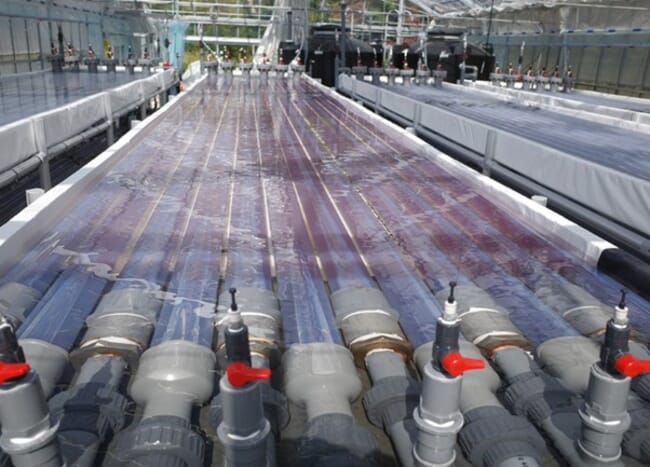
© Kyoto University and Symbiobe
Shota Kato from Symbiobe, a spin-out company from Kyoto University, says that marine purple photosynthetic bacteria could be the ideal sustainable alternative feed to fishmeal.
Samples of these bacteria, grown in a culture system in Symbiobe lab, then harvested and dried, contain about 70 percent crude protein, the team has shown.
“The amino-acid profile of this protein is closely comparable to that of fish meal,” Kato said in a press release. “It thus provides the ideal balance for growing fish.”
Air Feed
The sustainability credentials of the marine purple photosynthetic bacteria come from the very minimal inputs they need to grow and reproduce, according to Kato. As a photosynthetic organism, the bacteria gain the energy they need from sunlight.
Unlike many other photosynthetic organisms, however, certain marine purple bacteria can also directly use nitrogen from the air, fixing it as a source of the nitrogen required for growth. Thus, the microbes don’t need to be supplied with a synthetic form of fixed nitrogen, saving a significant amount of energy.
“Our bacteria can be cultured from atmospheric nitrogen, carbon dioxide and sunlight without any additional nutrition, which is a big advantage for sustainability,” Kato says.
The company has named its aquafeed product Air Feed, since fresh air is the only raw material that the bacterium requires for growth.
A prototype of Air-Feed-formulated compound feed.Credit: Symbiobe Inc.
The researchers says that the bacteria can be grown in inexpensive and readily available sterilised seawater, rather than having to be grown in liquid based on valuable fresh water.
In addition, bioreactors based on fresh water are at high risk of contamination by bacteria from the air. The salt content of seawater inhibits the growth of airborne bacteria that may enter the purple photosynthetic bacteria bioreactor, eliminating this potential source of contamination.
Deeper benefits
In lab-scale experiments, the team has shown that small freshwater fish could be maintained for several weeks on a feed consisting primarily of marine purple bacteria biomass combined with a small amount of commercial fish feed.
Two batches of purple photosynthetic bacteria.Credit: Symbiobe Inc.
“We’re about to start a collaboration with Kyoto University and several industrial partners, including a fish feed company and a fish farming company, to conduct a feeding trial for aquaculture fish species,” Kato said.
During this study, the feed will be trialled on species such as red sea bream, salmon and trout.
The team has also found that extracts of the marine purple bacteria have strong antioxidant activity.
“Feeding the bacteria to farmed fish may be useful in preserving meat quality by inhibiting oxidation during storage and transport,” said Yu Murakami, a researcher at Kyoto University.
Murakami has been leading a feeding trial study of the bacteria to Nile tilapia.
“We’ve found that feeding the bacteria to Nile tilapia can inhibit lipid oxidation of the fish meat. Thus the marine-purple-bacteria feed may help to maintain high levels of two key nutritionally beneficial omega-3 fatty acids found in fish,” he explained.
A source of astaxanthin?
Among the colourful chemicals that marine purple photosynthetic bacteria produce, the organisms synthesise and accumulate unique carotenoid pigments, the team has found. Certain carotenoids, particularly astaxanthin, are of interest to the aquaculture industry because they give several species including red sea bream, prawns and crabs their colour. Synthetic astaxanthin is often added to the aquaculture feed for these species to enhance the colouration of their meat and increase their consumer appeal.
The unique carotenoids in marine purple bacteria may offer a high-value alternative, natural source of additives for aquaculture species colouration, Kato says. The team is investigating ways to boost the production of target carotenoids in marine purple bacteria, including by looking for high-performing specimens in the ocean.
“In the near future, we may isolate some high-carotenoid-producing or carotenoid-storing species from the natural environment, to increase the production of carotenoids in our bacteria cells,” Kato said.
To meet the potential demand for their sustainable marine photosynthetic bacteria derived aquafeeds and additives, plans for scaling up their production facilities are ongoing, Kato says.
“For the practical use of our bacteria cells for feed production, feed companies require tons of feedstock at a time,” he says. “We’re collaborating with some major Japanese partners to construct our next photobioreactor plant at a semi-commercial scale.”
Once completed, the pilot plant will enable the team to confirm the economic feasibility of their process, as well as to assess other key sustainability metrics such as its carbon footprint.
“We hope to complete this step in the next three to four years,” Kato said.




